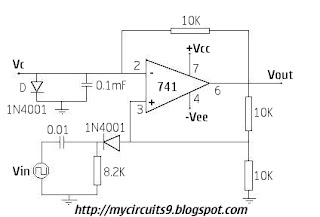CIRCUIT DIAGRAM OF OP AMP BASED MONOSTABLE MULTIVIBRATOR (741 IC)

MONOSTABLE MULTIVIBRATOR USING OP AMP 741
Monostable multivibrator is also called as One Shot Multivibrator. It has a Stable State and a Quasi-Stable State. The circuit remains in stable state until a triggering signal is applied to its input. After getting the triggering signal the output transit from stable to Quasi-stable state and return back after a time period. So a Single Pulse is generated for single Trigger.
Consider the instant at which the output Vo=+Vsat. At that time diode D1 damps the Capacitor voltage, Vc at 0.7V. Feedback voltage is +βVsat at Non-Inverting terminal. When the negative trigger is applied, the potential at Non-Inverting terminal becomes less than 0.7v the output switches to -Vsat, which makes the diode more negative than -βVsat. Comparator switches back to +Vsat. The Capacitor C starts charging to +Vsat through R until Vc reaches 0.7v and C becomes damped to 0.7v.
The pulse width is given by T=RC*ln(1/1-β).
You may also Like:-
Monostable Multivibrator Tutorial
Comments
Post a Comment